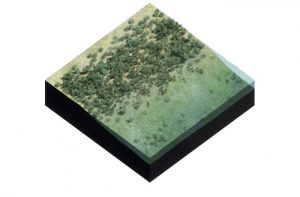Lithosphere – salt marshes
Soil subsidence: Marshes increase in elevation and thereby counteract soil subsidence. Typical marsh accretion rates are in the order of 10 mm per year. Very strong rates of soil subsidence (higher than the local marsh accretion rate) will most likely cause marshes to drown in the future. Especially as soil subsidence and sea-level rise together will determine how much marshes need to increase in elevation to prevent drowning in the near future.
Initial substrate suitability: the initial substrate is important in determining whether a marsh can form. Whether or not the initial substrate is suitable depends on the elevation, slope and grain size. These different aspects are each considered in more detail below.
- Elevation: At low tide, the marsh surface needs to be above water for vegetation to establish. The marsh needs to be flooded regularly to allow sediment to settle on the marsh surface. A pioneer zone is generally located at ~20 cm below Mean High Tide (max. 40 cm below MHT), whereas a low marsh is located at MHT (Van Duin & Dijkema 2012).
- Slope: The slope will reduce the hydrodynamic energy of the incoming water and therefore reduce local erosion rates. Marsh slopes can range between 1:50 and 1:500. A 1:100 slope would be advised for a new marsh (Van Duin & Dijkema 2012).
- Grain size: Salt marsh substrates can vary from pure sand to clay and peat. Marsh development generally starts on an initial bare sandy plane (Olff et al. 1997). Presence of fine-grained sediment (silt and clay) in the substrate will increase soil stability (Ford et al. 2016), it will enhance the chances of pioneer vegetation to establish and reduce erosion during storm events (Houwing 2000).
Drainage: During marsh development a natural drainage system generally forms consisting of a network of creeks. The drainage system forms due to feedbacks between vegetation, water flow and marsh morphology (Temmerman et al. 2007). From an engineering perspective, digging drainage channels is possible and stimulating drainage could increase the changes of pioneer vegetation to establish. However, this should not be necessary as channels should form naturally. It is advised to closely monitor the autonomous development of the drainage system.
Marsh accretion rate: a sufficient marsh accretion rate is essential for a sustainable marsh to develop. Sediment deposited on the marsh surface together with organic carbon accumulation from dead local plant material determines the potential increase in marsh elevation. Erosion and soil compaction negatively affect marsh accretion rate. All these processes together determine the nett marsh accretion rate that needs to be equal and preferably higher than the enhanced sea-level rise together with any soil subsidence present. Marsh accretion is therefore a resultant of the sphere parameters
- Fine grained sediment supply (Hydrosphere),
- Soil subsidence and
- Sea level rise (Athmosphere)
Marsh morphology: After initial pioneer vegetation establishes and marsh starts to develop, feedbacks between the vegetation, sediment deposition and local erosion will determine the marsh morphology. These feedbacks are a key feature of marshes. Patches of vegetation redirecting the water flow will cause a drainage system to form (Temmerman et al. 2007). Additionally, large heavy particles (sand) will travel a smaller distance from the sediment source (marsh edge or creek) than small lighter particles (silt) (Roner et al. 2016). The larger grains settle near the creeks, creating creek banks alternating with lower elevated depressions (Temmerman et al. 2004). This will positively affect plant diversity.
Nutrient availability: in the pioneer stage a limited nutrient availability limits the primary production. The local nutrient availability will increase as nutrient-rich sediment is depositing on the marsh surface (Olff et al. 1997). This stimulates primary production, results in vegetation succession to occur and plant diversity to increase.

